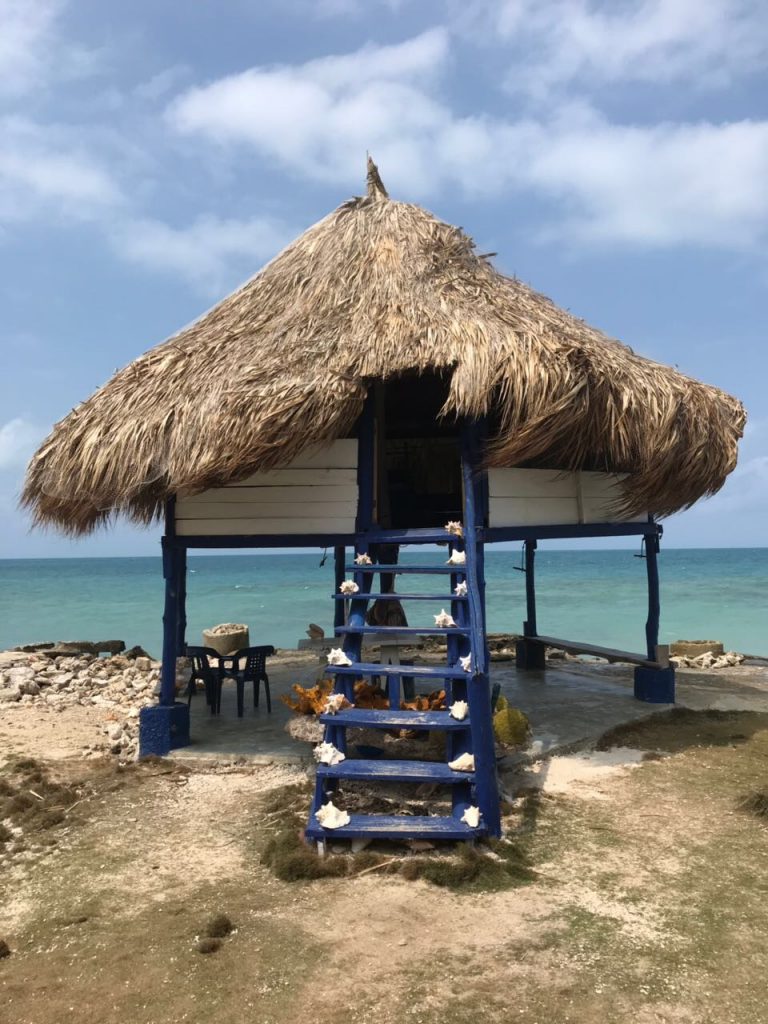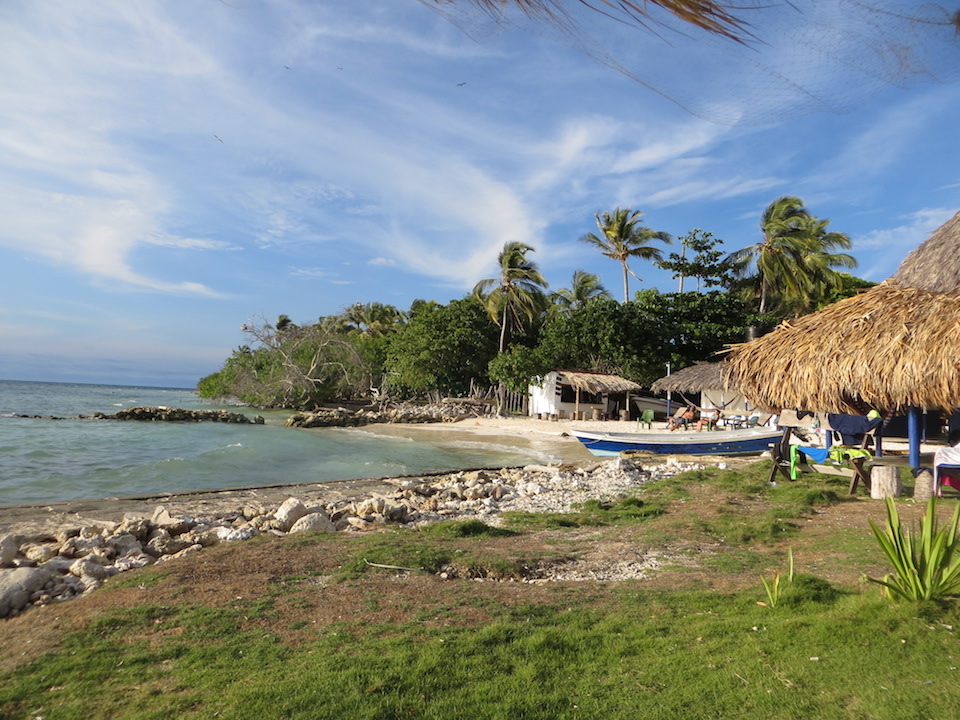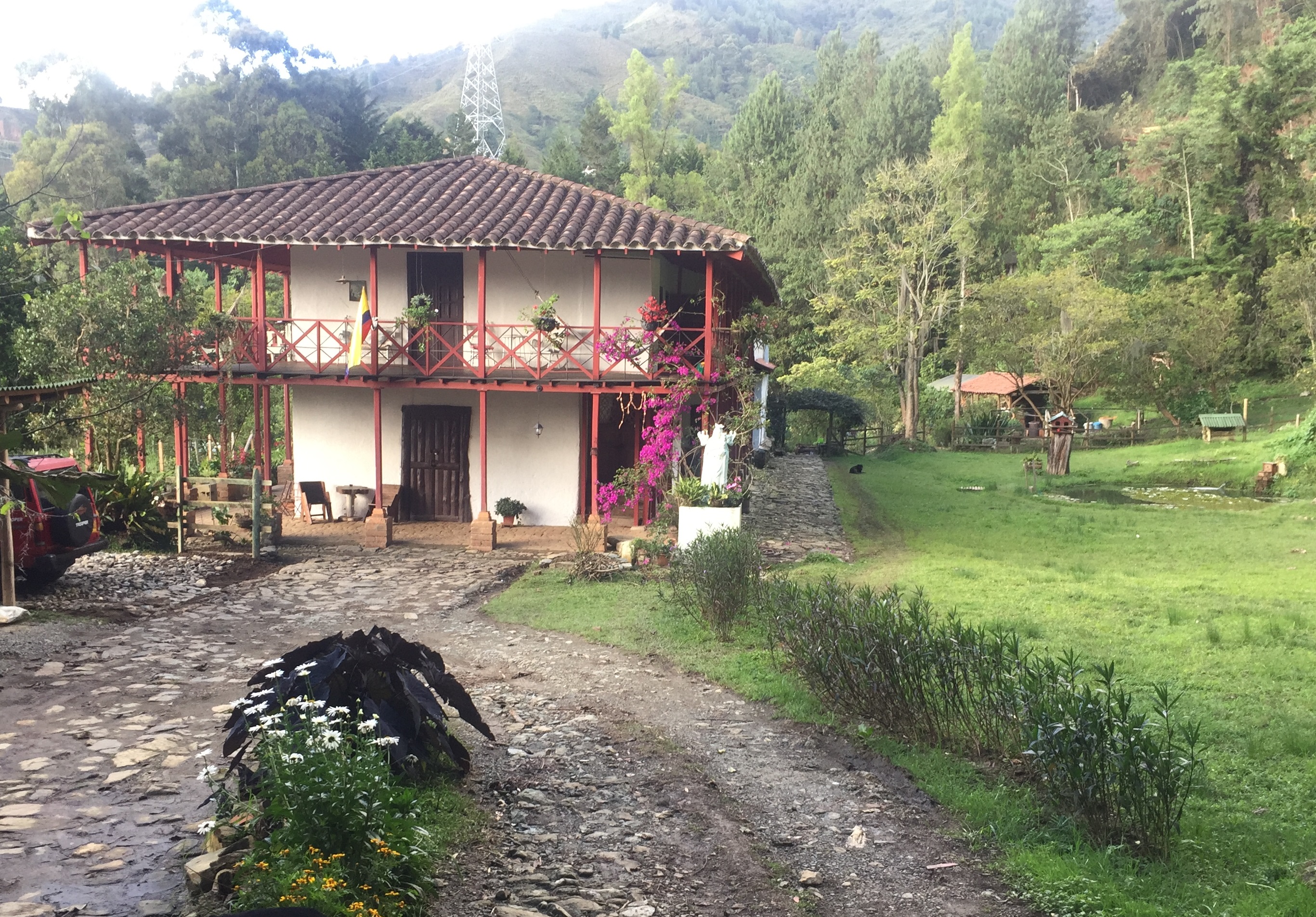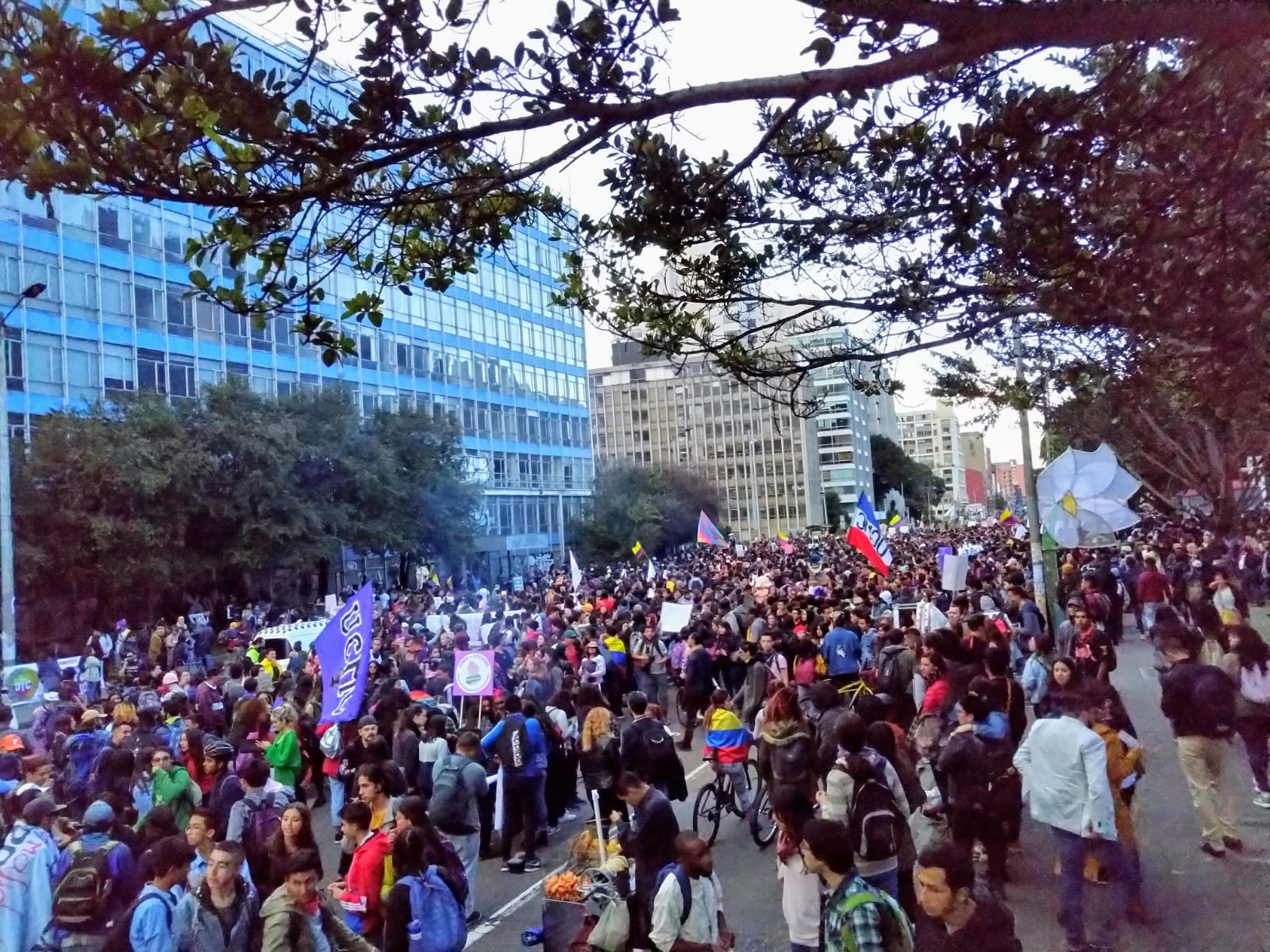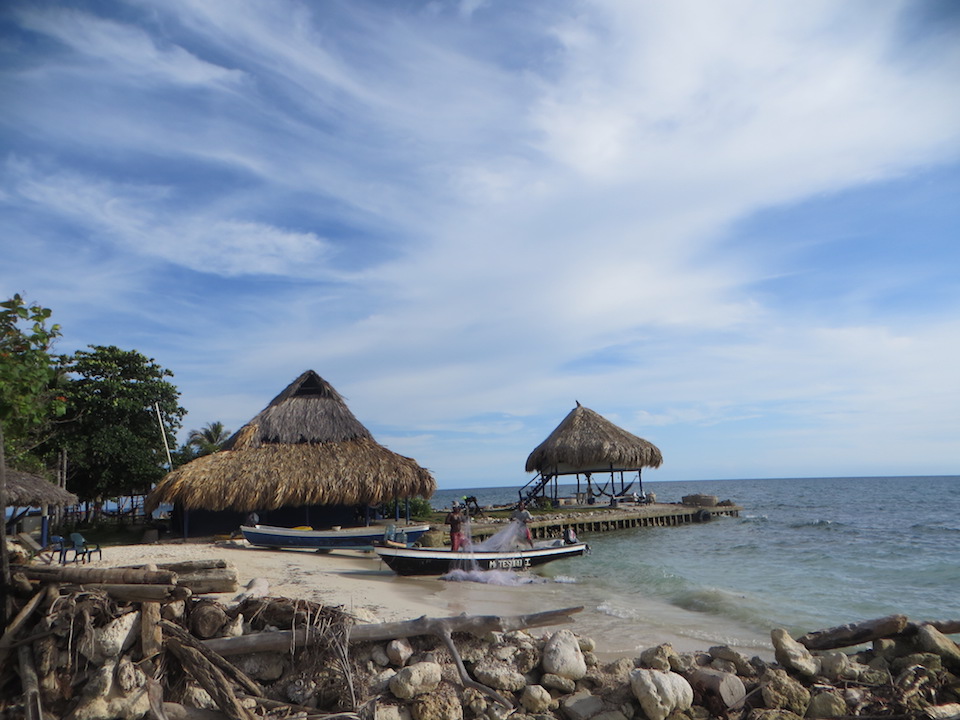
View onto the beach and the palm-covered cabins at the Dahlandia lodge on Isla Múcura. Photo: Stefanie Brandli
It’s sunshine and coconuts by day and plankton dancing by night on the Isla Múcura. Plus, if you take the scenic route, getting to this island paradise is half the pleasure.
It is pitch black when we jump into what turns out to be surprisingly warm water. And then the spectacle starts. With every swish of our arms and legs, the water fractures into a hundred tiny lightbulbs. The plankton glow white around us, like fairy lights brightening the darkest of waters.
We are on a night-time plankton light tour just off the Isla Múcura on the Caribbean coast. We have travelled through dark water for 15 minutes by the light of a weak torchlight. By the time the boat stops, we are already drenched from the splashes of waves hitting the boat and can just about make out that we are surrounded by branches of trees dipping into the water. The thought of diving into the black liquid – not knowing how deep it is or what else is meandering there – is quite intimidating. A squid, glowing neon-blue, swims past, inviting us to awaken more of the water’s nocturnal adventurers.
Once in the water, the sea salt keeps us afloat on the shadowy liquid cloud, reflecting the million stars hanging above us in the night sky. The only noises are the giggles coming from other nearby explorers and the occasional warning to switch off a torch. The more we dance, the more we paint the water with this lightshow.
Starry, starry seas
This moment cannot be captured by a normal flash or smartphone camera; any light will destroy the reflection of the plankton. But just as you always will remember a star-filled night, so this picture will stay clear in our minds.
Getting thereTo travel to Isla Múcura, take a boat from Cartagena, Tolú or Rincón del Mar. The boat leaves from the dock Bodeguita in Cartagena and from the Tolú port daily at 08.30, weather permitting. From Rincón del Mar there is no fixed schedule. Your lodge will be able to advise and help organise the reservation of the the boat transport from all three departure locations. If you go, stay at the Dahlandia Lodge, in one of the cabins overlooking the water. Alternatively, there is also a hostel and a more resort-type hotel on the island. |
The night tour is just one of several activities on offer when you travel to the Isla Múcura. Overlooked due to its location, and overshadowed due to its unpretentious size, the island is seeped with the same magic that one finds in many little-known Colombian destinations.
It’s not just the island, it’s the journey there that gently tugs away at the layers of city life with every stop we make. We catch an early flight from Bogotá to Montería where we catch up with some friends. Tropical breakfast juice in hand, we stroll along the Río Sinú and watch the raft-style passenger boats, being pulled by a rope from one riverbed to another. The river, which runs through the capital of Córdoba, provides a cooling relief against the mid-morning heat. Despite being labelled as a base for paramilitary activity, we are told that this is a quiet city which offers a pleasant springboard for the tranquil open waters of the nearby islands.
Photos: Artemis Maria Papoutsakis
The next leg of the journey takes us to Santa Cruz de Lorica for a fried fish lunch. We hop on a bus that follows the river down to this small town that has been named as one of the country’s 17 ‘Pueblos Patrimonios.’ Known for its fish, the town has a brightly coloured market hall that dates back to 1929 and is in itself as charming as the local women selling food there. Each stallholder calls out with a laughing smile, boasting they have fresher fish than their neighbour. We buy from the stall with the sweetest smell of arroz con coco and best riverside view to enjoy a filling lunch, washed down with a Costeña beer.
Related: A trip to the best spots in Colombia
That night we stay in the unassuming town of Tolú, a one-and-a-half-hour bus journey from Lorica. Our so-called detour is not only a wonderful chance to witness the way in which life, landscape and plants transform as we travel from inland towns to the coast, it also allows us to take the early morning boat from Tolú direct to Isla Múcura – one-and-a-half-hours instead of the more common and longer boat ride from Cartagena.
Boat jam
As we leave Tolú’s port, a commotion wakes our drowsy minds and bodies. Our boat has moved five metres before it halts because of a sand blockage at the exit to the small port. The men on each vessel are ordered to volunteer to jump into the water and heave the boat free. Thirty minutes go by as each boat in the traffic jam repeats this routine. Looking around at the other ten passengers – a mix of local tourists or coastal dwellers on their way back to work on an island, and the occasional city weekend traveller – no one seems bothered by the slight delay.
We set off and it’s not long before a busy mirage appears in the endless colour of the Caribbean Sea. We see a tiny island that seems to be fighting off the waves and at the same time being engulfed by makeshift houses. The boat’s guide tells us that El Islote is, “The world’s most populated island.” He explains that this small piece of land is home to those working on the larger privately-owned islands nearby. The inhabitants have stacked their huts on top of each other and across every bare rock, using earth and driftwood or odd materials picked up from the neighbouring waves.
Related: Adventure sports, high on adrenaline
When we arrive on Isla Múcura, we are welcomed by the person who manages our accommodation. The majority of the passengers will only spend a few hours before returning to sleep on the mainland. We, the lucky few, are guided barefoot through the island’s soft terrain and shown the island’s own little hub where a small group of locals reside. A few improvised houses surround the open and communal kitchen, dining and washing area.
Our lodge is one of the few accommodation options on Isla Múcura and consists of simple but beautiful cabins, with roofs made out of natural fibres. The abundance of seashells amazes us. They are so large in size that they have been built into parts of the lodge, and are also used to create a perimeter that marks the boundaries of the private beach.
After soaking up the sights on our way here, we are happy to skip the available activities, such as a tour back to El Islote or a snorkelling trip in nearby Isla Tintipán. Now we have finally arrived at our seaside paradise with a surplus of fresh coconuts, we are content to stay within the confines of the shells, savour the ocean breeze and soak up the sounds and colours of the creamy blue water.




